In this installment of our continuing series Fabric Explained, we discuss linen, the quintessential summer fabric.
History of Linen
Linen fabric is derived from the flax plant; the oldest cultivated plant known to man. The flax plant’s Latin name is Linum Usitatissimum, and from that, the word linen was derived. Archaeological evidence was found in a cave in Georgia (the country, not the state) from 34,000 years ago regarding the cultivation of flax. Around 3000 BC/BCE, Mesopotamians mastered the cultivation of the flax plant and they used it to create ropes, threads, and even clothing.
At the time, it was a luxury and as such it was reserved for the wealthier classes and for priests. The same was true in ancient Egypt, where linen fabric was a symbol of status and wealth. For example, their pharaohs were mummified in linen or flax fabric. It’s also referenced in the Bible many times, and from the Middle East it spread to Asia and Europe. Romans and Greeks believed that linen was a sign of purity and royalty.

Woodcut illustration of a Bible verse (Luke 16:19-31) by Jacob Locher, depicting “a rich man in purple and fine linen”
Around 700 AD/CE in France, linen was used as a sanitary fabric, and it also became more popular throughout Europe–especially in places like Ireland where it became a thriving trade. To this day, Irish linen is often referenced as a hallmark of quality for linen.
Why Was Linen So Popular?
It has always been a strong and sturdy fabric, and so it was used in many industries. Just think of books, table cloths, bed linens, canvases, upholstery, and so forth. Over the course of the last hundred years, linen has gotten a lot of competition from other fabrics like cotton, wool, or cashmere, but also artificial fibers such as viscose. Today, more and more people are becoming interested in linen again, not just because of its strength and longevity but also because of its eco-friendliness.
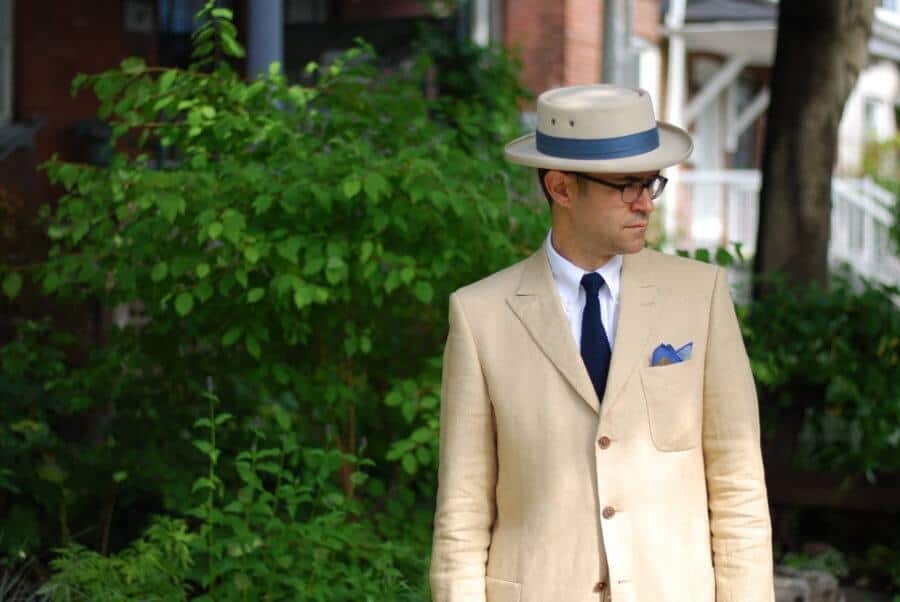
Pedro Mendes with dark blue knit tie, white button-down shirt and ivory linen suit with crown fold pocket square – note the unusual hat
Characteristics of Linen Fabric
1. Strong, Durable, Crisp & Absorbent
First of all, it is stronger, more durable and also more lustrous than, for example, cotton. It is also quite crisp and absorbent.
2. Heat- and Moisture-Wicking
It typically wears rather cool, because the weave is a little looser than most cotton or wool fabrics. Because of that, linen fabric usually feels more porous, and a lot of people appreciate its heat- and moisture-wicking abilities.

The weave of linen is typically loose enough to let air through.
3. No Pilling
On top of that, you won’t have any problems with pilling because the fibers are very long or type of static, which you might experience with polyester or other artificial fibers.
4. Wrinkly (In A Good Way)
Typically, high-quality flax fibers are between 18 and 30 inches long. While it makes them durable, it also means they’re not very likely to relax, which means linen is a very wrinkly fabric. Unlike the wrinkles in cotton (which make you look a bit more frumpy), the really pronounced characteristic wrinkles of linen are a sign of a sophisticated casual style.
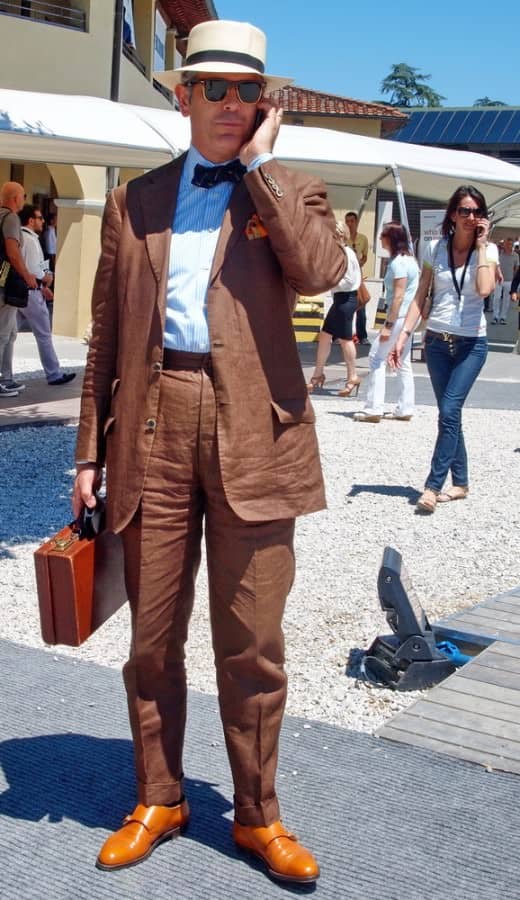
Wrinkled Linen Suit via Stile Maschile
5. Dyes Easily
Because linen is absorbent, it also takes dye very easily, and it typically comes in many different colors.
6. Softens Over Time
Because linen doesn’t stretch much naturally, it pays to have garments to cut a little wider. But when you do that, over time the fabric becomes softer and you’ll cherish the garment even more.
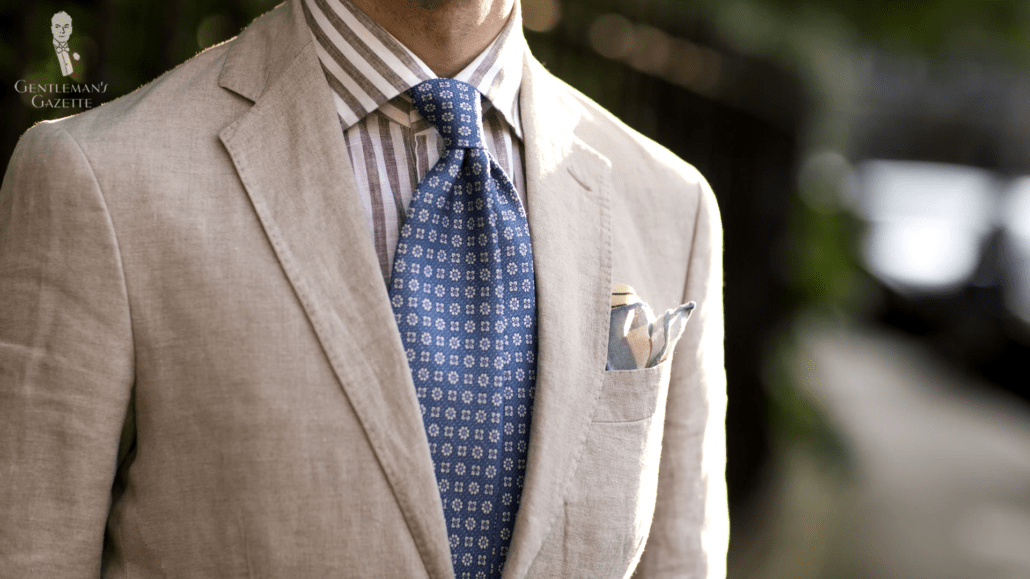
Notice the wrinkles of this linen jacket
How Is Linen Made?
It all starts with the flax plant, which is mostly cultivated in Europe these days, in places like France, Belgium, the Netherlands, Italy, or Ireland. Of course, flax is also cultivated in other countries such as Canada or China, but most people would consider the European flax to be the best for high-quality linen fabric. The process from a flax plant to a linen fabric is actually quite complicated, which makes it a somewhat special craft.
Harvesting
The flax is typically harvested after a hundred days of growth. Harvesting flax is a delicate process because it has to be uprooted rather than just being cut. Why? Well, if the stalk is cut you’ll have some sap, which impacts the fibers negatively. It used to be done all by hand and was labor-intensive. Today, it can be done by machines.
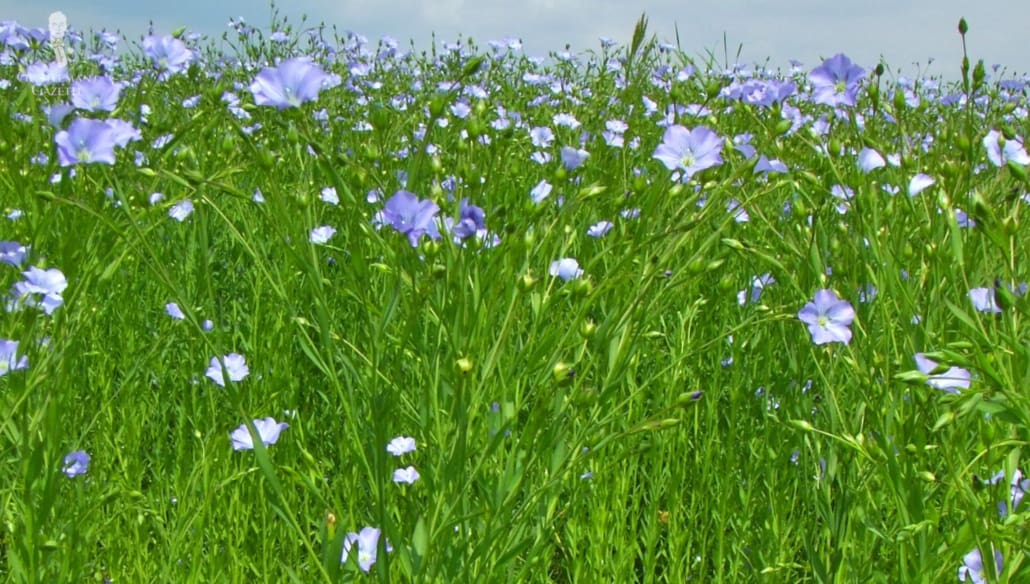
The flax plant, from which linen fibers are derived
Rippling & Retting
In the second step, the plants are rippled, which means the seeds are removed. Next comes retting, whereby the Flax plants are left outside in the field, where they experience the elements such as rain and sun. That makes the outside bark loosen up, which makes the flax plant ready for the next step in linen production.
Scutching
In this step, you will take the dried flax stalks and put them into a flax break, crushing the inside part of the flax and leaving the flax fiber exposed. These small broken pieces are called shives and they were traditionally removed during the scutching process, using two pieces of wood to remove the residual bark from the fibers. Today, all of this is done by a scutching machine with rotating paddles removing all the shives neatly, and just leaving the nice flax fibers.

Once dry, the flax plant is gathered to be scutched and combed (credit: George Washington’s Mount Vernon)
Combing
Because flax is a natural material, fibers have different lengths–but for linen production, you only want the long fibers. And to get those, you had to traditionally comb the fibers so the short ones would stick in the comb and you are left with the long, good ones. Of course, the flax combing process is now also all done by machines and the result is better and faster.
Spinning & Reeling
In the next step, the blonde, hairlike, 18 to 30-inch long flex fibers are then spun into a yarn. The yarn is then reeled on spools and sent through a hot-water bath which ensures a cohesive yarn and lends the yarn some shine. The finished yarn reels are wound into bobbins and then they can be used for weaving fabric.
Weaving
The weaving of linen is very similar to other fabrics such as wool, silk, or cotton. So, before you actually weave the fabric, the flax yarn is inspected for moisture content, tensile strength, cohesion, and color consistency. The yarn bobbins are made into warp beams which can be up to 10 kilometers or 6 miles long.

After weaving, manual checking and repairing of faulty linen fabric is complete (credit: Victoria and Albert Museum)
Traditionally, linen was handwoven in a very slow mechanical process. Today, you have high-speed looms that create fabric pretty quickly. And just like with any woven fabric, they’re inspected afterward to find and remedy any defects, and then it’s time to send it to the finishing department.
Finishing
Linen is typically washed, bleached, and dyed, and sometimes it also receives a water-repellent or fire-repellent treatment. Just like with wool or cotton, there’s a different range of qualities for apparel fabrics, and the weave and the weight of linen has a huge impact on how it drapes and how it wears.

Summer linens rank as the most casual of fabrics for their “rough” texture and their tendency to wrinkle easily.
Types of Linen
1. Irish Linen
Generally, the most popular linen used for clothing is often referred to as Irish linen, and it’s typically about 10 to 13 ounces heavy. Personally, I find that designation confusing, because in Ireland, they produce linen of all kinds of weights and weaves, so this is more a historical term that’s not really helpful to the consumer.
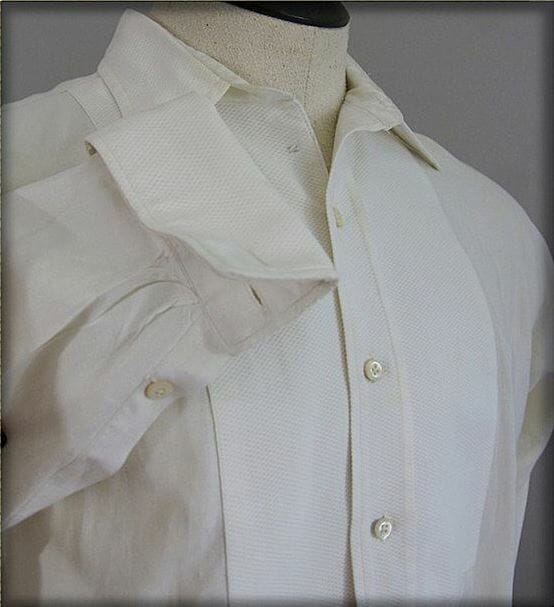
An antique Marcella dress shirt dating from the 1920s or 30s. Made in Derry from Pure Irish Linen.
In my experience, heavier linen drapes better and the wrinkles you see are maybe a bit larger and wider, and not as pronounced as the linen of lighter fabrics. This type of linen is often used for suits, because it looks very sophisticated.
2. European Linen
Another common linen is European linen, which is usually about 8 to 9 ounces heavy, and therefore shows more wrinkles than the heavier linen. Some people like to use this linen, especially in very hot climates because it usually wears a bit cooler. It is also used for shirts or things like shorts.
3. Cambric Linen
An even lighter variety is the so-called Cambric linen, which is usually about 6 ounces heavy. It often has a mottled, two-tone characteristic which gives you a very casual look. Because of that, it’s popular with shirting fabrics as well as pocket square fabrics. If you’d make a pocket square out of a heavy 13-ounce Irish linen, it would just be too big in your pocket and look unsightly.
At Fort Belvedere, we pay great attention to detail and so all of our high-quality, hand-rolled Italian linen pocket squares have the exact size that is perfect for the weight of the linen.
4. Linen Blends
The hard-wearing properties of linen are also often utilized to blend with other fibers such as cotton or polyester. Lately, it has also been blended with wool which leads to quite interesting results. Typically, the heaviest linens can reach all the way up to 15 ounces but they’re typically reserved for tablecloths or bed linen and not used for the apparel industry because they’re just too heavy and stiff.
What Are The Environmental Impacts of Linen?
Next to hemp, linen is probably the most eco-friendly fiber or fabric out there. Even though they’re technically not necessary, chemical fertilizers, herbicides and pesticides are used in linen production, which is not so great for the environment. Also, if the process of retting takes place in rivers that obviously pollutes the river with certain chemicals but there are now also things like enzyme-retting that are much more environmentally friendly.

The seeds of the flax plant can be used to make linseed oil
On the bright side, flax can be cultivated even under poor soil conditions with very little water, which means it uses relatively less water compared to, like, cotton. On top of that, everything of the flax plant can be used. On the one hand, you can actually use the flax seeds and you can make linseed oil. The fibers that are not appropriate for the linen fabric can be used to make burlap or sewing thread for heavy leather. While most linen fabrics are actually dyed and colored, an undyed piece of linen is actually biodegradable.
How To Buy Linen
Knowing that it’s not just a strong and sturdy fabric that has a nice sheen but it’s also very environmentally friendly, how should you go about buying linen garments and what do you have to pay attention to? As I mentioned before, the best quality linens come from Europe. Personally, we’ve worked with French, Belgian, Irish, and Italian linen and they have all been very high quality. If we’d have to pick one as the winner, it would probably be Italian linen because, the Italians have really mastered the finishing process in fabrics (and they also dominate the wool fabric trade because of it.)
Tip #1: Check the Origin & Base Material
Find out where the linen is from and what base material was used.
Tip #2: Look at the Weight & Weave
If you want something heavier, 10 to 13 ounces is good; something lighter weight but 8 to 9 ounces is better and 6 ounces is great for shirts or pocket squares. That being said, the weight alone doesn’t determine how cool something wears.

Open weave shirt fabric, ideal for summer
The weave is also very important, and if you have a looser weave and you can see more air holes, that’ll mean you’ll feel every breeze more easily than if you have a very tightly woven linen. You can really feel the difference if you stand in front of a fan, for example. Alternatively, you can hold up your linen towards a strong light source and see which one shows more light.
How To Style Linen Garments
Pocket Squares
Typically, we recommend that the first pocket square every man should own is a white linen pocket square with a hand-rolled edge. We offer them without monograms or with your hand-monogrammed initial in our shop. Of course, we also have other linen colors and they come with a fine, contrasting cross-stitch and they add a really nice texture and it just looks very handsome.

100% Linen Pocket Squares by Fort Belvedere
Suits & Sports Coats
Because it is typically a warm-weather fabric, most linen suits will have a single-breasted silhouette–simply because you have just one layer of fabric rather than a double layer of fabric over your chest and belly. However, with the popularization of double-breasted styles in modern casual sport coats in recent years, you can now also find double-breasted linen suits and sport coats.
As linen is prone to wrinkling, it has typically a more casual character and if you go for a linen sport coat or a jacket, I think it looks best with patch pockets because they underline that casualness. They just look better than jetted or flap pockets. In the same vein, a pair of contrast buttons simply make things more relaxed and more appropriate for a linen suit or sport coat.
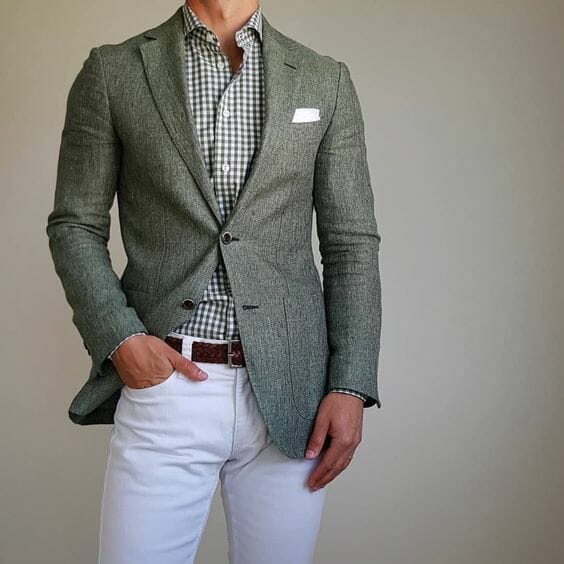
Linus Norbom wearing a green linen jacket with a green and white gingham shirt and white pants
Pants
Because linen fiber is not flexible and it doesn’t stretch, I like my linen garments to be cut slightly on the looser side and because of that a pair of pants for me typically has pleats and even shorts should have pleats, they’re just more comfortable to wear that way. I also think the extra room works well for a more casual summer look.

Sophisticated Wrinkles of Cotton and Linen Blend Fabric
Shirts
Some people also like linen for shirts including dress shirts or things like Henley shirts or popover shirts. Overall, it’s a very casual shirt so make sure you have a very soft collar and soft cuffs and skip the stiff interlining. If you’re not sure if a linen shirt is right for you, you can find out even at places like Uniqlo for about $30. They even have a great range of color and you can see if it works for you.
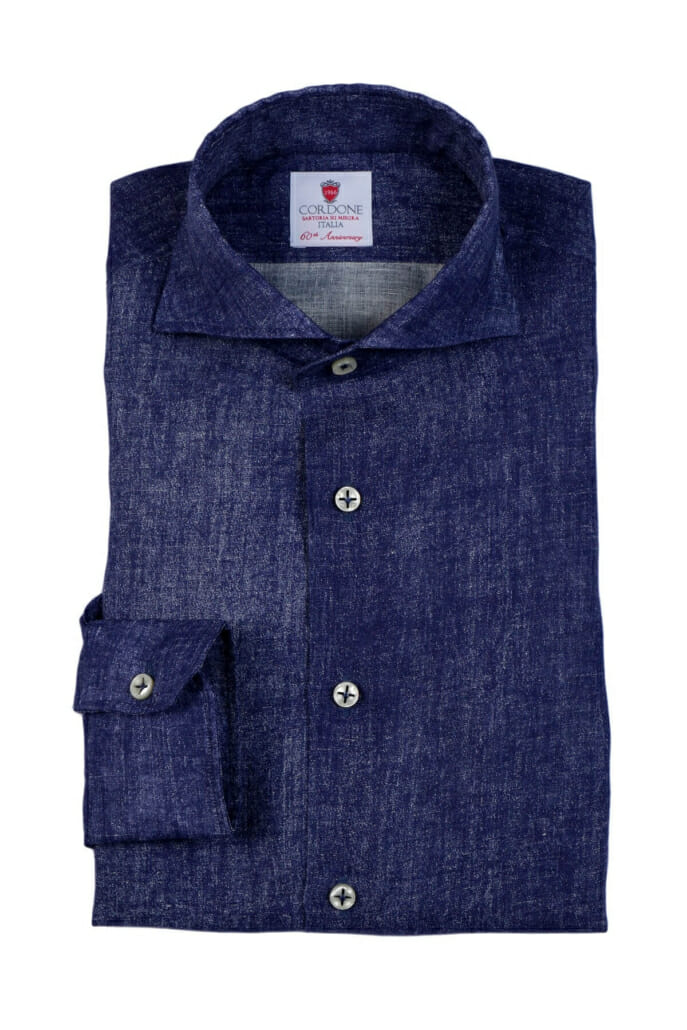
A linen denim shirt from Cordone 1956
Typically off the rack, most linen shirts are going to be in solid colors of pastel. If you go for custom shirts, you can find a much greater range of patterned linen in herringbones, dots, or checks. It really gives you the ability to create a one-of-a-kind shirt that cannot be found off the rack.
Sweaters
In recent years, I’ve also found linen sweaters. Personally, I always find them a bit harsh on their own, and rather than going with a 100% linen sweater, maybe a blended linen and cotton sweater are much more preferable.

A sweater in blended cotton and linen from Polo Ralph Lauren
Soft Accessories
Linen can also be great for things like neckties or bow ties because they really casualize your outfit. Overall, when it comes to accessories or garments, linen is a great way to make things breezier, lighter, more summery, and overall more casual.

Linen ties in 3-fold construction, made by hand with a soft interlining – perfect for summer outfits.
How To Care For Linen
On the bright side, linen fabrics don’t have lint and they’re not prone to pilling so you don’t have to worry about that. To clean, a warm hand wash or delicate machine wash is best. Ideally, use a mild laundry detergent but always stay clear of bleach, because that will ruin your linen garment.
If you find a stain on a linen garment, you can dilute some hydrogen peroxide or use some laundry detergent in water and let it soak for about 30 to 45 minutes. Always keep in mind that harsh scrubbing or rubbing is not great for linen because the weave is typically a little coarser and it will just be more likely to destroy the garment. Make sure it’s properly rinsed and then, let it air dry and don’t put it in the dryer.

A lukewarm hand wash or machine wash in delicate cycle cleans linen best.
How To Iron Linen
Linen wrinkles a lot, and therefore it’s best ironed. Fortunately, you can iron it with very high heat and you don’t need an extra cloth, like you would need with wool. It’s best ironed with a steam iron or ideally when it’s still slightly moist so you can remove all the wrinkles from it. Keep in mind, though, that linen will always wrinkle and it’s just part of the charm of the fabric. Don’t work against, it just learn to live with it!
What is your favorite linen garment and what feature do you most enjoy about the cool-wearing fabric? Share with us in the comments!
from Gentleman's Gazette https://ift.tt/3fkdjXh

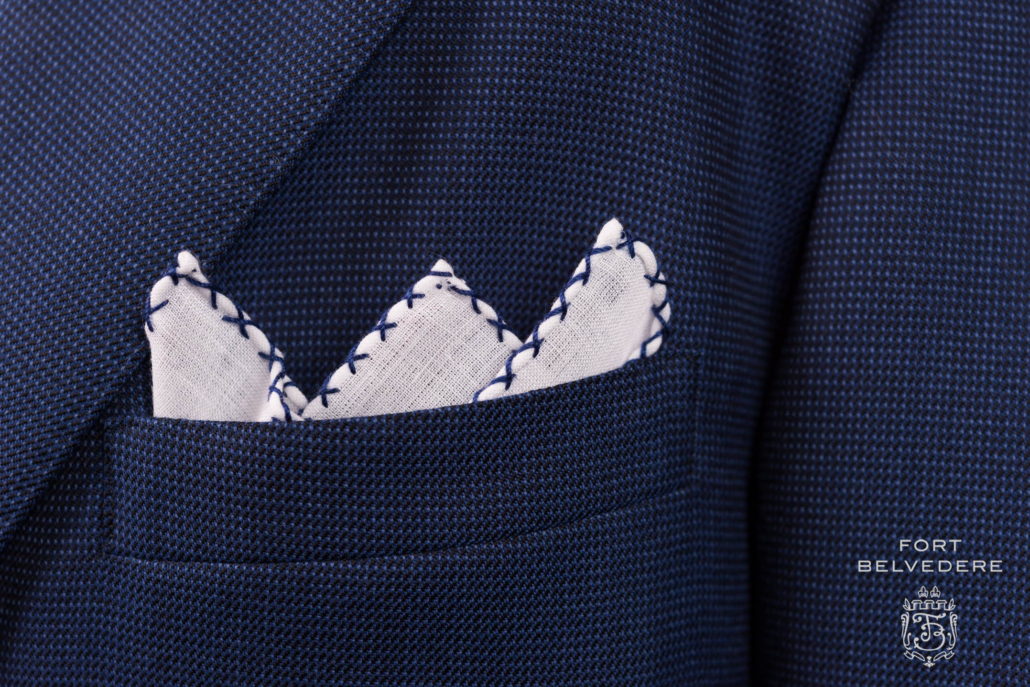

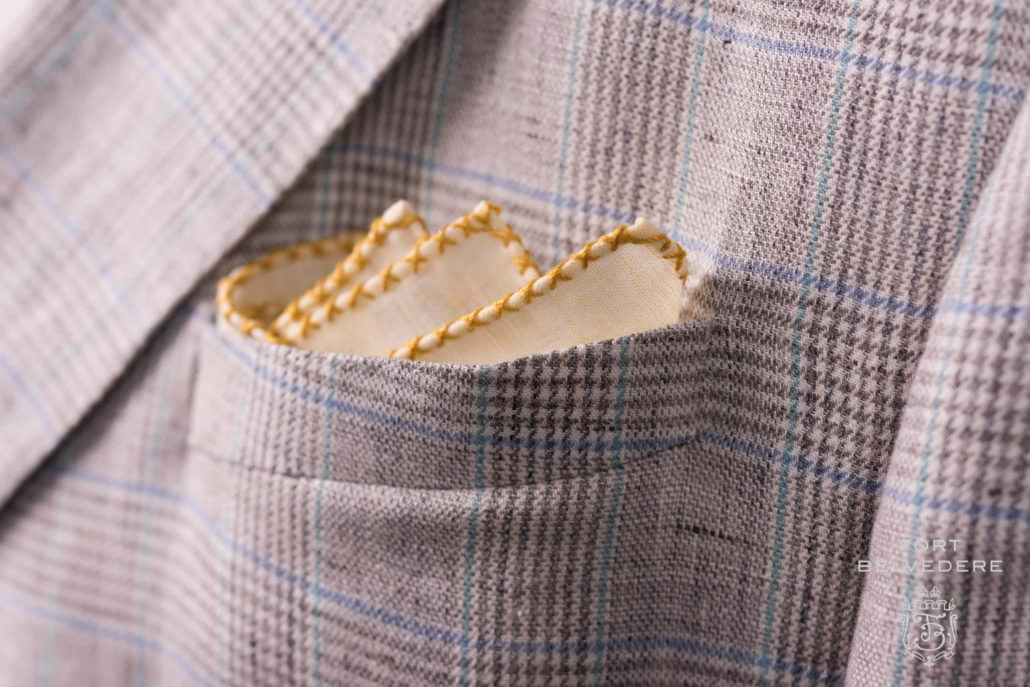
0 Comments